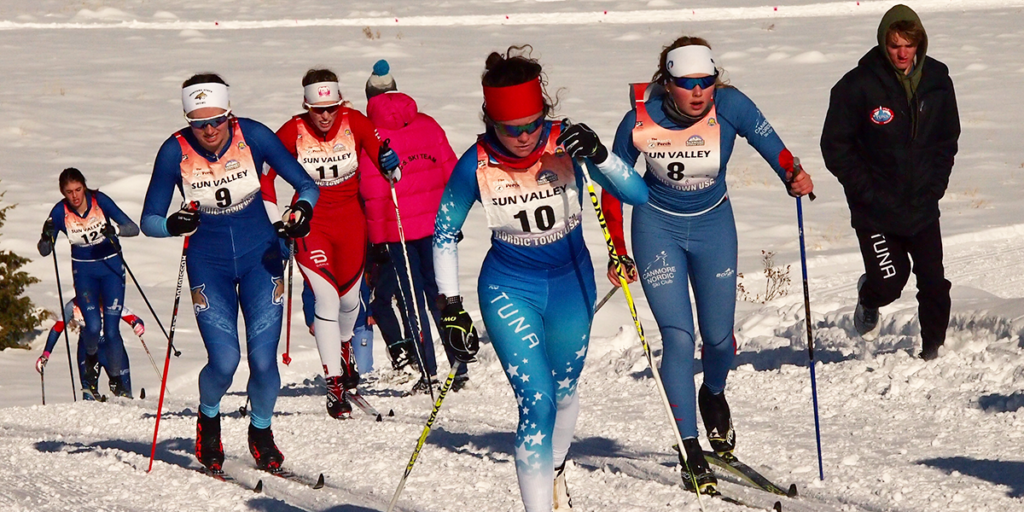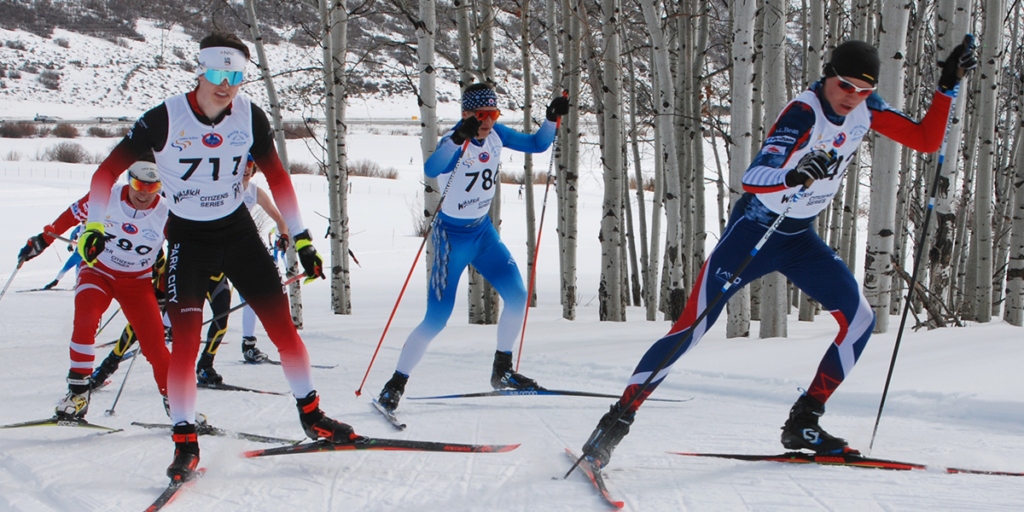Are you new to Nordic skiing? Start here!
Q: Where can I find ski equipment?
A: There are a number of local shops that sell and rent Nordic ski equipment. REI, Backcountry.com, White Pine Touring, and Wasatch Touring are four places that sell and rent Nordic ski equipment.
Q: Where should I ski?
A: There are so many places to ski. TUNA maintains the Mountain Dell Golf Course as a ski track in the winter. It’s the most wallet-friendly place for dedicated track skiing. Get yourself a membership and then a season pass to ski, here. Kids under 18 ski free! We also offer day passes for $10, 70+ passes for free, and student passes. Email Membership@utahnordic.org.
Q: Do I need a lesson?
A: You will enjoy Nordic skiing so much more if you start by learning from an experienced skier. Luckily we have many classes for all levels! Check out the store, here, for our junior and adult programs. Read more about the junior programs, here.
Skate or Classic? What’s That?
Classic Skiing

Classic skiing is the “original”. When you think of Nordic skiing, or cross country skiing, this is that. Also known as “diagonal stride”, it can mimic alpine touring or running on skis. This is the original type of skiing, which then evolved into jumping, alpine skiing, ski touring, backcountry, and track skiing.
Classic skis tend to be longer, a little floppier, and have some way for the ski to grip the snow in the middle third of the ski. Some have a carved rough spot called “fishscales”, some must be waxed with a sticky wax in the middle called “kick wax”, and some have small climbing skin, mohair or nylon sections, that allow the ski to grip. The tip and tail of the skis are waxed with a smooth glide wax.
Classic boots are low, soft, and more like shoes.
Classic poles are slightly shorter, coming to about your armpit.
Skate Skiing

Skate skiing looks like its name — it’s like speedskating with poles. What started as a shrewd development to go faster in races, skating was made popular by American Bill Koch. Skating is much faster, so it is now disallowed in “classic” races.
Skate skis are shorter and stiffer skis with only a gliding surface. The entire ski is waxed with smooth glide wax.
Skate boots are stiff and higher, and allow more support for the lateral push of skating.
Skate poles are longer, coming up to between the chin and nose.
Should I Skate or Classic?
Most programs start the youngest kids on classic skis with no poles. Except for Learn-To-Ski, which is only classic, the rest of TUNA’s junior programs split their time evenly between both techniques. TUNA offers adult lessons in both techniques.
Why Classic?
Classic is, after all, the original kind of skiing. It’s difficult, and it’s also difficult to do wrong. You either stick or you don’t, and when you do it’s because you’ve achieved the appropriate shift in weight from one foot to the other.
Runners take well to classic skiing because the motion is very similar.
Many people don’t want to classic ski because they’re concerned about the complicated waxing. With fishscale skis, and especially today’s skin skis, the waxing issue is no longer a problem, and you can just clip in and enjoy.
Why Skate?
Skating is fast and fun. Many people who skate love the simplicity of the ski, and the fact that you can just clip in and go.
Cyclists tend to like skating because it uses many of the same muscles as cycling. It’s also easier to make forward progress on your first day.
Fitting Skis, Boots, and Poles
Boots
Fitting Nordic ski boots isn’t complicated. Classic and skate should both fit about like a running shoe, perhaps a tiny bit tighter. You don’t want your toes to touch the front of the boots, especially with classic, but you also don’t want your heels to slip.
Most Nordic boots come in European sizes like 39, 40, 41, etc., but also have US sizes printed in. Trying them on is the best bet, though, because just like shoes, the fit varies by manufacturer.
Poles
Skate poles should come up to between your chin and nose. Beginners often find it easier to learn with the poles on the shorter end of that, but proper length will help you learn the correct technique. Too long and your hands won’t move back to position fast enough, too short and you won’t generate much power. Other than that, the price of the poles will increase as they get lighter.
Classic poles need to come to about your armpit. If they are too long, it’s hard to get the proper motion of classic. Too short, and power decreases.
Skis
Both skate and classic skis are sold by your weight, not height. In both cases, the ski is designed to have the most contact with the ground.
For classic, when you’re standing on evenly-weighted feet, the “kick zone” or middle of the ski should be off the ground, but when you have all your weight on one ski, it should touch the ground.
Skate skis are slightly less curved, but also work best when a single weighted ski completely contacts the ground.
The tricky part about buying skis is that most manufacturers sell skis in 4 or 5 lengths. Within that length, however, there is a range of “flex”. Top skiers get pretty picky about those in-between numbers, but beginner and intermediate skiers just need to get within a good range to start.
A Bit about Bindings
Are you confused yet? Well let’s just make things a little better when it comes time to purchase equipment, especially if you’re looking at used skis and boots.
There are three kinds of bindings on the market right now: NNN, SNS, and ProLink. The binding and the boot must match in order for them to clip together.
NNN, or New Nordic Norm is the most common. It’s found on every brand except Salomon. Chances are, unless it’s really old, if your boots and bindings are NOT Salomon, you’re good to go (a few exceptions exist in very old equipment). NNN is usually stamped on the bottom of the boot and on the binding.
SNS, or Salomon Nordic System, is a proprietary setup that Salomon used for years, and much of this type are still floating around. Salomon equipment is just fine, but you must assure that the boots and bindings are both SNS in order for them to work.
ProLink is Salomon’s newest boot/binding type. The good news is, ProLink works with NNN. That means newer Salomon equipment can be used with other brands and itself as long as it is all ProLink.
Good news! Poles are compatible with everything!